4/1/2019
LEDs: Blue & Far-Red Light
Yujin Park & Erik Runkle
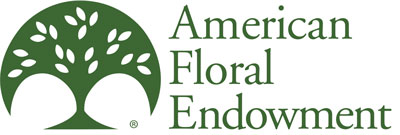
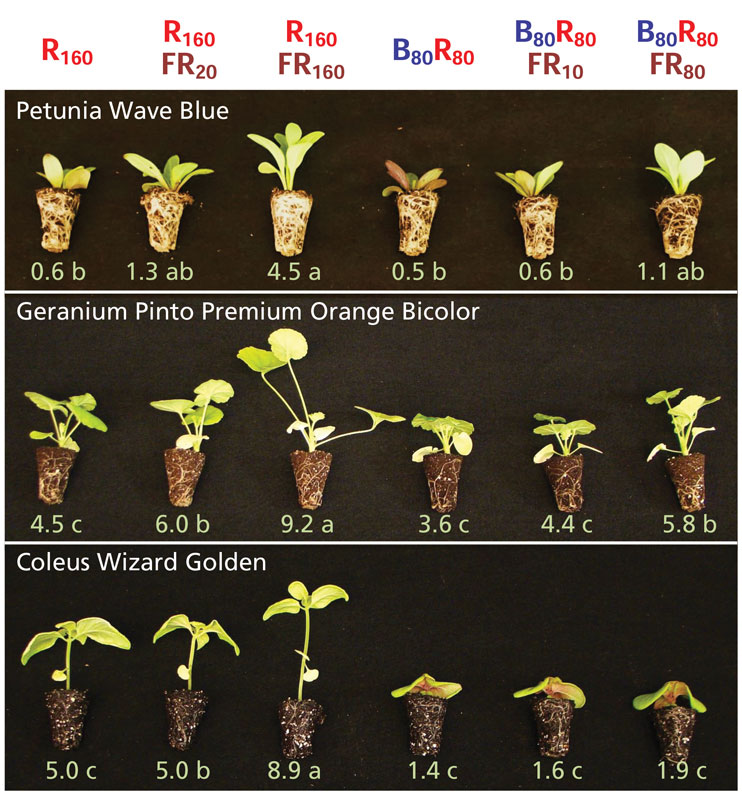
The terms light quality and light quantity are often confused or used interchangeably. Light quantity refers to the intensity or brightness of light. The most common light quantity measurement is photosynthetic photon flux density, or PPFD, which is the total number of photons from 400 to 700 nm. This waveband is considered the most useful for photosynthesis.
In contrast, light quality refers to the spectral distribution or color of light. The effects of light quality on plant growth and development are not only affected by individual wavebands of light and their intensity, but also how they interact with one another. For example, plant responses to far-red (700 to 800 nm) light can depend on PPFD and blue (400 to 500 nm) light intensity.
Figure 1. Seedling heights (cm) of petunia, geranium and coleus at the transplant stage. Seedlings were grown at 68F (20C) under six indoor LED lighting treatments. The subscript value after each LED type (B = blue; R = red; FR = far red) indicates its photon flux density in µmol•m–2•s–1. Seedling heights followed by the same letter are statistically similar.
In Part 2 of this series (the March issue of GrowerTalks), we presented information about how far-red light interacts with PPFD to regulate seedlings of floriculture crops grown under a fixed blue light intensity. We concluded that the inclusion of far-red light can promote seedling growth, regardless of PPFD, when blue light intensity is kept constant. However, the promotive effects of far-red light on subsequent flowering depend on the PPFD.
The effects of far-red and blue light on plant growth and development have often been investigated individually. In general, far red promotes stem elongation and leaf expansion. In addition, in some long-day plants, far-red light also promotes flowering. However, far red also can make leaves slightly less green in color because leaf size is increased and the concentration of chlorophyll is decreased. In contrast, blue light suppresses extension growth and increases leaf chlorophyll concentration.
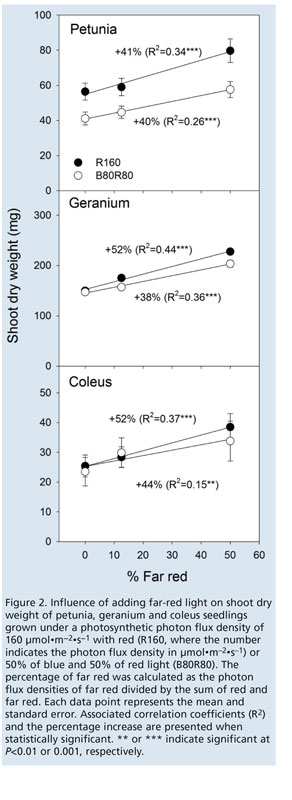 In this study, we investigated how far-red light interacts with blue light to regulate extension growth, leaf chlorophyll concentration and subsequent flowering of ornamental seedlings. In particular, we wanted to determine whether including a moderately high intensity of blue light could nullify the effects of far red on stem elongation without inhibiting flowering.
In this study, we investigated how far-red light interacts with blue light to regulate extension growth, leaf chlorophyll concentration and subsequent flowering of ornamental seedlings. In particular, we wanted to determine whether including a moderately high intensity of blue light could nullify the effects of far red on stem elongation without inhibiting flowering.
Experimental protocol
Seeds of Geranium Pinto Premium Orange Bicolor, Petunia Wave Blue and Coleus Wizard Golden were sown in 128-cell plug trays by Raker-Roberta’s and received at Michigan State University (MSU) about one week later. When the first true leaves emerged, the seedlings were thinned to one plant per cell. They were then grown under each of six LED lighting treatments in a refrigerated growth chamber at a constant 68F (20C) and an 18-hour photoperiod.
All six LED lighting treatments delivered a PPFD of 160 µmol•m–2•s–1 from red light alone (R160, where the number indicates the photon flux density in µmol•m–2•s–1) or 50% of blue and 50% of red light (B80R80). In each R160 and B80R80 treatment, three red (600 to 700 nm) to far-red ratios (R:FR) were tested, including 1:0 (without far red), 8:1 and 1:1. Growth attributes of seedlings were evaluated after approximately three to five weeks under the LEDs when they were ready for transplant.
In addition, at the end of the plug stage, seedlings were transplanted into 4-in. pots and subsequently grown in a common greenhouse at 68F (20C) with a 16-hour photoperiod to determine whether the lighting treatments had any residual effects after transplant. For geranium and petunia, we determined days to the first open flower from transplant, the number of visible flower buds or inflorescences, and plant height at flowering. For coleus, plant height was measured when they were considered of marketable size. The experiment was performed three times for petunia and geranium and twice for coleus. Data were statistically analyzed and
interpreted.
Research results
Stem elongation. Without blue light, seedling height of petunia, geranium and coleus increased, as more far-red light was added (Figure 1). However, with 80 µmol•m–2•s–1 of blue light, adding far-red light had little effect on seedling height in petunia and coleus. In geranium, blue light suppressed the promotive effects of far red on stem elongation by 46%.
Dry weight. Shoot dry weight is an effective indicator of plant growth. It’s measured by cutting each plant at the surface of the growing substrate, drying it in an oven and then measuring its weight. Shoot dry weight of petunia, geranium and coleus increased linearly, by up to 41% to 53%, as the portion of far-red light increased, regardless of blue light (Figure 2). Only in petunia, blue light reduced shoot dry weight (by 24% to 28%) at the same portion of far red.
Leaf chlorophyll. The soil and plant analyzer development (SPAD) value is an index of relative leaf chlorophyll concentration. A lower value indicates a decrease in chlorophyll concentration and a lighter color green leaf. Adding far-red light decreased the SPAD value of petunia by 41% and geranium by 24%, regardless of blue light. In coleus, far-red light had little effect on leaf chlorophyll concentration. In all species, blue light increased SPAD value at each intensity of far red.
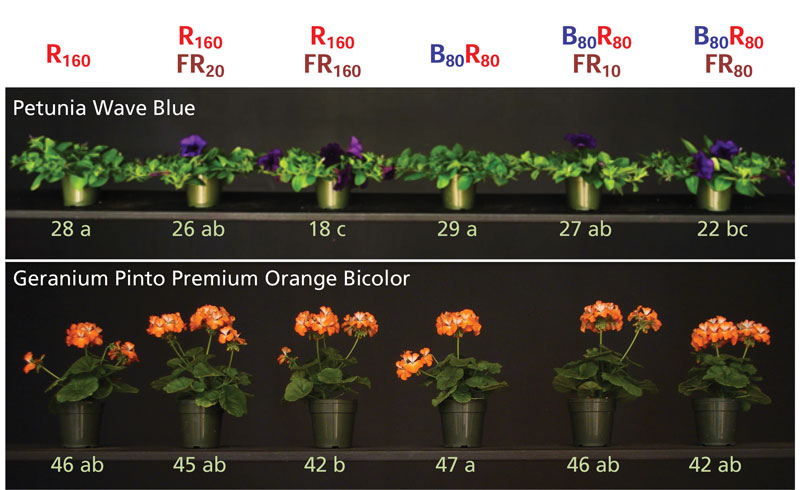 Subsequent flowering and plant height at finishing. In the long-day plant petunia, regardless of blue light, the plants provided with far-red light at R:FR = 1:1 during the seedling stage flowered seven to 10 days earlier than those grown without far red (Figure 3). In day-neutral geranium, far red treatment during the seedling stage had little effect on subsequent flowering at each blue light level. However, the plants grown with an R:FR = 1:1 and without blue light flowered five days earlier than those grown without far-red light but with blue light.
Subsequent flowering and plant height at finishing. In the long-day plant petunia, regardless of blue light, the plants provided with far-red light at R:FR = 1:1 during the seedling stage flowered seven to 10 days earlier than those grown without far red (Figure 3). In day-neutral geranium, far red treatment during the seedling stage had little effect on subsequent flowering at each blue light level. However, the plants grown with an R:FR = 1:1 and without blue light flowered five days earlier than those grown without far-red light but with blue light.
Figure 3. Influence of six indoor LED lighting treatments during the seedling stage on average days to subsequent flower at 68F (20C) and a 16-hour photoperiod. The subscript value after each LED type
(B = blue; R = red; FR = far red) indicates its photon flux density in µmol•m–2•s–1. Average days to
subsequent flower from transplant followed by the same letter are statistically similar.
In both petunia and geranium, plant height at flowering were similar among lighting treatments. In contrast, coleus plants grown with an R:FR = 1:1 and without blue light were taller than those grown without or with 10 µmol•m–2•s–1 of far-red light but with blue light (Figure 4).
Conclusions
Our results showed that inclusion of 80 µmol•m–2•s–1 of blue light suppresses the promotive effects of far red on stem elongation, but has little effect on flowering. In addition, including blue light increases leaf chlorophyll concentration independently of far red, so leaves are slightly darker green. We can conclude that including far-red light with a moderately high intensity of blue light in an LED spectrum can promote flowering in at least some long-day plants, while still producing compact plants with greener leaves. GT
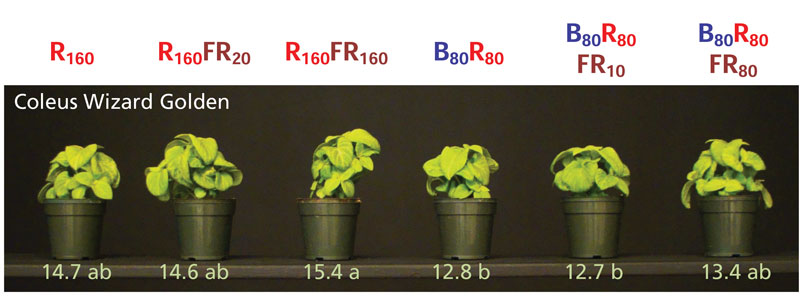 Figure 4. Influence of six indoor LED lighting treatments during the seedling stage on plant height (cm) of coleus at the finishing stage. The subscript value after each LED type (B = blue; R = red; FR = far red) indicates its photon flux density in µmol•m–2•s–1. Plant heights followed by the same letter are statistically similar.
Figure 4. Influence of six indoor LED lighting treatments during the seedling stage on plant height (cm) of coleus at the finishing stage. The subscript value after each LED type (B = blue; R = red; FR = far red) indicates its photon flux density in µmol•m–2•s–1. Plant heights followed by the same letter are statistically similar.
Acknowledgements: We thank the American Floral Endowment, OSRAM Opto Semiconductors, OSRAM Innovation, Michigan State University’s AgBioResearch, and Floriculture Research Alliance partners and horticultural companies for supporting research and outreach programs at MSU.
Yujin Park (parkyuj2@msu.edu) is a Post-doctoral Research Associate and Erik Runkle (runkleer@msu.edu) is Professor and Floriculture Extension Specialist in the Department of Horticulture at Michigan State University.